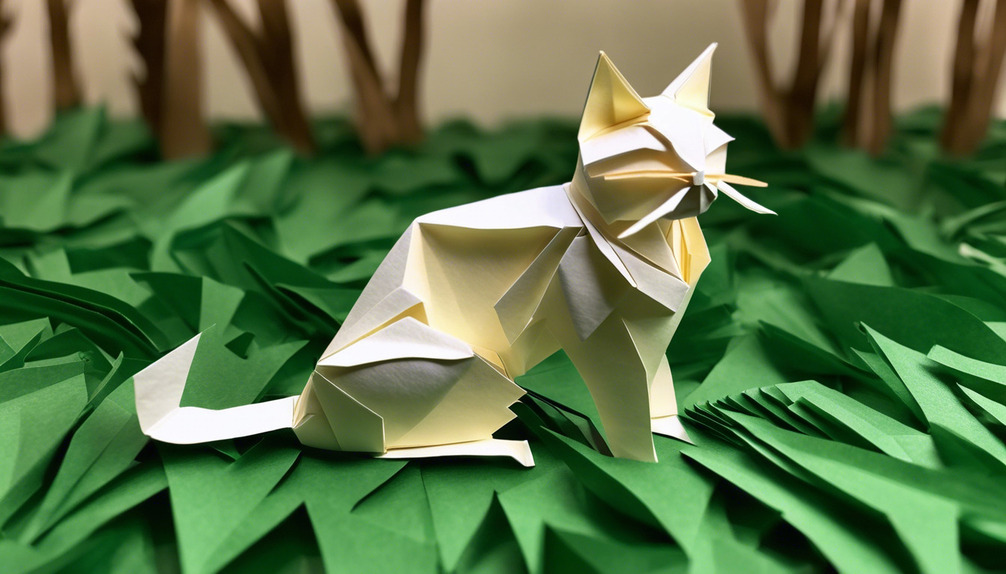As our beloved pets age, maintaining an optimal weight becomes increasingly crucial for their vitality and longevity.
But fear not, for there are safe and effective weight loss strategies specifically tailored for older cats.
Whether your whiskered cat has packed on the pounds due to a decrease in activity or a medical condition, understanding the best approach to help them slim down can feel like navigating a labyrinth.
Don’t worry, we’ll explain how to safely help your older pet lose weight, providing guidance focused on care and health.
Key Takeaways
- Consulting a veterinarian is essential to ensure the safety and well-being of older cats during weight loss.
- Gradual weight loss is recommended, with a target of 1-2% of body weight per week, to avoid adverse effects.
- Transitioning to a new diet should be done gradually over a two-week period to minimize digestive upset.
- Incorporating regular exercise and playtime is important to promote weight loss and overall health in older cats.
Consulting a Veterinarian
Before starting a weight loss program for your older cat, make sure to talk to a vet to keep them safe and healthy. It’s very important to get a vet’s advice to help with your senior cat’s weight problems.
Your vet will assess your pet’s current weight, determine the ideal weight, and devise a personalized weight loss plan. They’ll also conduct diagnostic tests to rule out any underlying health conditions that may be contributing to the weight gain. Consulting a veterinarian is essential before making any changes to your cat’s diet. They can recommend the right type and amount of food to help your pet shed those extra pounds safely.
Obesity in senior cats can lead to various health problems, so seeking professional help is crucial. Your veterinarian understands the unique needs of senior cats and can guide you in providing the best care for your beloved pet. Remember, your vet is there to help and support both you and your cat on this weight loss journey.
Determining Weight Loss Goals
As you focus on determining weight loss goals for your older cat, consider the invaluable guidance your veterinarian can provide to ensure a safe and effective plan. Discuss your cat’s ideal body weight with your vet, taking into account factors like breed and age.
Weigh your cat or use a body condition score to assess their size and health. For an average house cat, the ideal weight falls between 8 and 10 pounds, with a body condition score of 3 out of 5 considered ideal.
Your vet can help you establish a healthy weight loss goal for your cat, ensuring that the process is gradual and safe. Healthy weight loss for a cat is around 1-2% of their body weight per week.
When determining the amount of food to feed your cat, consider their current weight and adjust their portion sizes accordingly to support weight loss. Keep in mind that rapid weight loss can be detrimental to your cat’s health, and gradual weight loss is key to avoiding any adverse effects.
With your vet’s guidance, you can set achievable weight loss goals for your cat, supporting their journey towards a healthier weight.
Transitioning to New Diet
When transitioning your older cat to a new diet, it’s important to proceed gradually to minimize any potential digestive upset. Your cat may take time to adjust, so it’s crucial to be patient and understanding throughout this process.
Here’s how you can make the transition as smooth as possible:
- Make a plan for changing your cat’s diet gradually. This will help your cat adjust to the new food without causing any digestive issues.
- Slowly transition from the current diet to the new one over two weeks to help your cat adjust. This gradual change will be much easier for your cat to handle.
- Monitor for any bad reactions to the new food during the transition period. Keep a close eye on your cat’s behavior and any changes in their health.
Incorporating Exercise
As your older cat adapts to their new diet, it’s important to engage them in play and physical activity to promote weight loss and overall well-being.
Incorporating exercise is crucial for obese or overweight cats as it helps burn calories and improves muscle tone. Use interactive toys, laser pointers, or feather wands to encourage movement. Set aside dedicated playtime each day to help your cat stay active.
Consider using vertical climbing surfaces or cat trees to stimulate exercise. Remember that helping your cat lose weight isn’t just about reducing food intake but also about increasing physical activity. Cats that are overweight are at an increased risk of developing serious health issues such as fatty liver disease, so it’s crucial to keep your cat on a weight loss program that includes exercise.
If you encounter challenges in getting your cat to exercise, don’t hesitate to contact your veterinary clinic for advice. Your commitment to helping your cat maintain a healthy weight will significantly contribute to their overall well-being.
Patience in Weight Loss
I know it can be difficult to see your beloved cat struggle with weight issues. The desire for quick results is natural. But it’s important to remember that weight loss takes time. Rushing the process can do more harm than good.
Slow, Steady Progress
In the journey of helping your older cat achieve a healthier weight, it’s important to embrace the concept of slow, steady progress with patience at the forefront. Remember, your cat needs your love and support as they embark on this weight loss journey.
Here are some crucial points to keep in mind:
- Your cat should lose no more than 1 to 1.5 percent of their total body weight per week. Rapid weight loss can lead to health issues, such as fatty liver disease.
- Monitor your cat’s caloric intake and ensure they’re receiving balanced meals. Consulting your veterinarian for a tailored meal plan can greatly benefit your cat’s weight loss journey.
- Excess weight in older or obese cats can cause various health complications, so slow and steady progress is key to their well-being.
Your patience and dedication will make a world of difference in your cat’s health and happiness.
Avoid Rapid Changes
Embracing the importance of patience in your older cat’s weight loss journey is crucial to avoid health complications and ensure their well-being. Weight loss in older cats should occur gradually to prevent serious health issues such as hepatic lipidosis, also known as fatty liver syndrome.
Avoid rapid changes in their diet or caloric intake, as sudden alterations can lead to detrimental effects on their health. It’s essential to consult with a veterinarian before introducing new food or making any significant changes in their weight loss plan. Drastic changes can make your cat sick, so it’s crucial to monitor their progress and schedule specific times for thorough health exams.
Implementing Feeding Strategies
To help your older cat lose weight, it’s important to focus on how you feed it.
Portion control and feeding frequency are key points to focus on as you work towards your cat’s weight loss goals.
It’s important to approach these feeding strategies with care and empathy, knowing that gradual changes and consistent monitoring will ultimately lead to success for your beloved cat.
Portion Control
Consider implementing feeding strategies, such as scheduled mealtimes and using interactive feeders, to help your older cat maintain portion control and prevent overeating while on their weight loss journey.
It’s crucial to measure and feed the appropriate amount of food for weight loss. Here’s what you can do:
- Measure and feed the appropriate amount of food for weight loss.
- Use interactive feeders to slow down eating and encourage portion control.
Consult with a veterinarian to determine the ideal portion size and feeding frequency for weight loss.
- Avoid free-feeding and ensure portion control to effectively manage calorie intake for weight loss.
Feeding Frequency
To support your older cat’s weight loss journey, it’s important to carefully consider the feeding frequency and implement effective strategies to help them achieve their health goals. When determining how much to feed your cat, it’s crucial to consider the amount of calories they need to consume for safe weight loss.
Feeding smaller meals more frequently throughout the day can help control hunger and prevent overeating. Utilizing an automatic feeder can assist in releasing food at specific intervals, ensuring your cat receives the right portion sizes at the right times. This method also helps in monitoring their calorie intake and adjusting portion sizes as needed.
By implementing these feeding strategies, you can support your older cat’s weight loss journey while ensuring they receive the necessary nutrition.
| Feeding Frequency Strategies | Benefits |
|---|---|
| Feed smaller meals several times a day | Controls hunger and prevents overeating |
| Utilize an automatic feeder | Ensures consistent portion sizes and timing |
| Monitor calorie intake | Adjust portion sizes as needed for weight loss |
| Gradually transition to a new diet | Helps cats adjust to changes in feeding routine |
Frequently Asked Questions
How Do I Get My Indoor Cat to Lose Weight?
You can help your indoor cat lose weight by controlling portion sizes, promoting exercise through play and interactive toys, and avoiding free-feeding. It’s essential to consult a veterinarian for a tailored weight loss plan.
Why Is My Old Cat Getting skinny but Still Eating?
Your old cat may be getting skinny but still eating due to various health issues such as hyperthyroidism, diabetes, or kidney disease. It’s crucial to consult a vet to determine the underlying cause and develop a suitable treatment plan.
Why Do Cats Get Bony as They Age?
As cats age, they may get bony due to a natural decrease in muscle mass, reduced appetite, dental problems, hyperthyroidism, or underlying health issues. It’s important to provide them with proper care and attention as they age.
Why Is My 15 Year Old Cat so skinny?
Your 15-year-old cat being very thin is worrying. You should see a vet to find out why. It’s important to change its diet and have regular vet visits. Your cat’s health should be a top concern.




